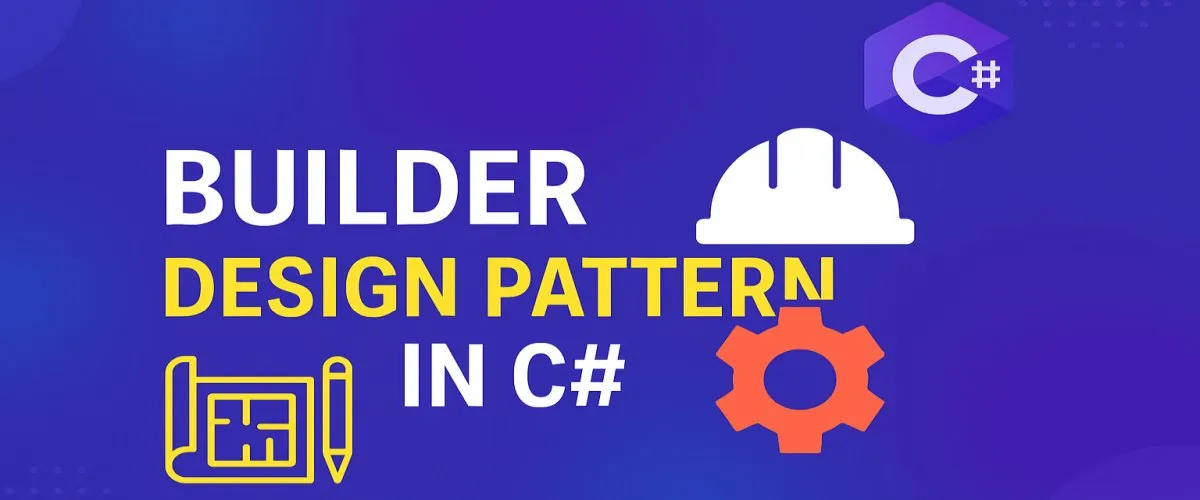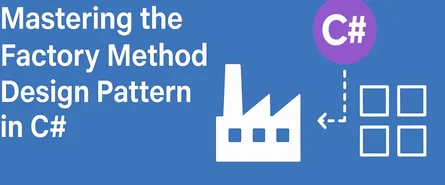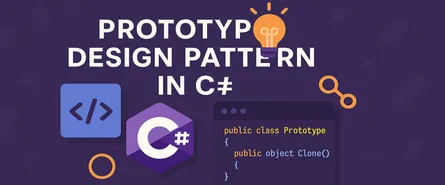
Mastering the Builder Design Pattern in C# — Simplifying Complex Object Construction!
Ever felt overwhelmed by complex object construction? Ever found yourself lost in a maze of overloaded constructors? Or worse—ending up with code so messy it makes spaghetti jealous? If yes, then you’re in the right place! Let’s dive into the Builder Design Pattern, a magical tool that can turn the chaos of object creation into something beautiful and easy.
What Exactly is the Builder Design Pattern?
Think of the Builder Design Pattern like your favorite sandwich shop. You walk in, and instead of yelling out your 15-ingredient sandwich all at once, you carefully choose each ingredient step-by-step—bread, veggies, meat, sauce, cheese—exactly how you like it. This pattern follows a similar philosophy: breaking down the process of building a complicated object into small, manageable steps.
The Builder pattern separates the construction of a complex object from its representation, letting you produce different representations of an object using the same construction process.
In other words, separation of concerns is the name of the game!
Principles Behind the Builder Pattern
Here’s what makes the Builder Design Pattern tick:
-
Single Responsibility Principle (SRP):
- Every class or module has only one reason to change. Builders handle object creation, and your main class doesn’t have to worry about it.
-
Open/Closed Principle (OCP):
- You can extend object construction without changing existing code.
-
Step-by-step construction:
- Objects are built incrementally. No overload soup here!
-
Separation of Construction and Representation:
- The client can create different representations with the same construction process.
When Should You Use the Builder Pattern?
Wondering when to whip out the Builder pattern? Here’s your checklist:
- Complex Object Creation: When your objects require numerous parameters or steps to construct.
- Readable and Maintainable Code: If readability is critical, the Builder is your friend.
- Multiple Representations: Need various ways to build the same object? Builder’s got your back.
- Avoiding Telescoping Constructors: If you find yourself drowning in constructor overloads—time to build!
Key Components of the Builder Pattern
There are four main characters in this story:
- Product: The final object you want to create.
- Builder Interface: Defines methods to build parts of the product.
- Concrete Builder: Implements the builder interface, assembling the product.
- Director: Uses the builder interface to construct an object.
Let’s visualize it:
- Product → The Sandwich
- Builder Interface → Menu listing the sandwich-building steps
- Concrete Builder → Sandwich Artist
- Director → The Customer ordering a sandwich step-by-step
️ Implementing the Builder Pattern with C# (Detailed Example)
Let’s create a real-world example—building a computer configuration. You’ll see the magic unfold clearly in C#.
Step 1: Define the Product (Computer)
// The product class
public class Computer
{
public string CPU { get; set; }
public string GPU { get; set; }
public string RAM { get; set; }
public string Storage { get; set; }
public override string ToString() =>
$"Computer [CPU={CPU}, GPU={GPU}, RAM={RAM}, Storage={Storage}]";
}Step 2: Builder Interface
public interface IComputerBuilder
{
void BuildCPU();
void BuildGPU();
void BuildRAM();
void BuildStorage();
Computer GetComputer();
}Step 3: Concrete Builder Implementation
// Gaming Computer Builder
public class GamingComputerBuilder : IComputerBuilder
{
private Computer _computer = new Computer();
public void BuildCPU() => _computer.CPU = "Intel i9-14900K";
public void BuildGPU() => _computer.GPU = "NVIDIA RTX 5090";
public void BuildRAM() => _computer.RAM = "64GB DDR5";
public void BuildStorage() => _computer.Storage = "2TB NVMe SSD";
public Computer GetComputer() => _computer;
}Step 4: Director Class
public class ComputerDirector
{
public void ConstructComputer(IComputerBuilder builder)
{
builder.BuildCPU();
builder.BuildGPU();
builder.BuildRAM();
builder.BuildStorage();
}
}Putting It All Together:
class Program
{
static void Main(string[] args)
{
ComputerDirector director = new ComputerDirector();
// Building a gaming computer
IComputerBuilder gamingBuilder = new GamingComputerBuilder();
director.ConstructComputer(gamingBuilder);
Computer gamingComputer = gamingBuilder.GetComputer();
Console.WriteLine(gamingComputer);
// Output: Computer [CPU=Intel i9-14900K, GPU=NVIDIA RTX 5090, RAM=64GB DDR5, Storage=2TB NVMe SSD]
}
}See how clean and neat that was? Welcome to Builder-land!
Diving Deeper: Different Ways to Implement the Builder Pattern in C#
You’ve seen the basics, but let’s expand on three practical and powerful ways to implement the Builder Pattern in C#. This time, we’re diving deep, complete with detailed explanations and solid examples, so get comfortable!
Method 1: Fluent Builder (Method Chaining)
The Fluent Builder approach is about creating objects using readable, chained method calls. It’s like ordering at Starbucks: “I’ll have a tall, extra-hot latte with almond milk and caramel drizzle.”
Example Implementation:
// Fluent Builder for a Pizza
public class Pizza
{
public string Dough { get; set; }
public string Sauce { get; set; }
public string Cheese { get; set; }
public List<string> Toppings { get; set; } = new List<string>();
public override string ToString()
{
return $"Pizza [Dough={Dough}, Sauce={Sauce}, Cheese={Cheese}, Toppings={string.Join(", ", Toppings)}]";
}
}
public class PizzaBuilder
{
private Pizza _pizza = new Pizza();
public PizzaBuilder SetDough(string dough)
{
_pizza.Dough = dough;
return this;
}
public PizzaBuilder SetSauce(string sauce)
{
_pizza.Sauce = sauce;
return this;
}
public PizzaBuilder SetCheese(string cheese)
{
_pizza.Cheese = cheese;
return this;
}
public PizzaBuilder AddTopping(string topping)
{
_pizza.Toppings.Add(topping);
return this;
}
public Pizza Build()
{
return _pizza;
}
}
// Usage
var myPizza = new PizzaBuilder()
.SetDough("Thin crust")
.SetSauce("Tomato basil")
.SetCheese("Mozzarella")
.AddTopping("Olives")
.AddTopping("Mushrooms")
.Build();
Console.WriteLine(myPizza);
// Output: Pizza [Dough=Thin crust, Sauce=Tomato basil, Cheese=Mozzarella, Toppings=Olives, Mushrooms]Pros:
- Highly readable.
- Easy to extend.
- Simple object creation process.
Method 2: Builder with Nested Inner Class
Here, your builder lives right inside the class it builds, like nesting dolls. It feels compact, clean, and self-contained.
Example Implementation:
// Inner class Builder for User
public class User
{
public string FirstName { get; private set; }
public string LastName { get; private set; }
public string Email { get; private set; }
public int Age { get; private set; }
private User() { }
public override string ToString()
{
return $"User [FirstName={FirstName}, LastName={LastName}, Email={Email}, Age={Age}]";
}
public class Builder
{
private readonly User _user = new User();
public Builder WithFirstName(string firstName)
{
_user.FirstName = firstName;
return this;
}
public Builder WithLastName(string lastName)
{
_user.LastName = lastName;
return this;
}
public Builder WithEmail(string email)
{
_user.Email = email;
return this;
}
public Builder WithAge(int age)
{
_user.Age = age;
return this;
}
public User Build()
{
return _user;
}
}
}
// Usage
var user = new User.Builder()
.WithFirstName("Alice")
.WithLastName("Johnson")
.WithEmail("alice@example.com")
.WithAge(30)
.Build();
Console.WriteLine(user);
// Output: User [FirstName=Alice, LastName=Johnson, Email=alice@example.com, Age=30]Pros:
- Encapsulated within the product class.
- Easy-to-understand structure.
- Self-documenting object creation.
Method 3: Abstract Builder Pattern with Director
This version adds more abstraction, perfect for scenarios needing multiple representations using a standard construction procedure. Imagine building houses with standardized processes but different blueprints.
Example Implementation:
// Abstract Product
public class House
{
public string Foundation { get; set; }
public string Structure { get; set; }
public string Roof { get; set; }
public override string ToString()
{
return $"House [Foundation={Foundation}, Structure={Structure}, Roof={Roof}]";
}
}
// Builder Interface
public interface IHouseBuilder
{
void BuildFoundation();
void BuildStructure();
void BuildRoof();
House GetHouse();
}
// Concrete Builders
public class WoodenHouseBuilder : IHouseBuilder
{
private House house = new House();
public void BuildFoundation() => house.Foundation = "Wooden Foundation";
public void BuildStructure() => house.Structure = "Wooden Structure";
public void BuildRoof() => house.Roof = "Wooden Roof";
public House GetHouse() => house;
}
public class BrickHouseBuilder : IHouseBuilder
{
private House house = new House();
public void BuildFoundation() => house.Foundation = "Concrete Foundation";
public void BuildStructure() => house.Structure = "Brick Structure";
public void BuildRoof() => house.Roof = "Tile Roof";
public House GetHouse() => house;
}
// Director
public class ConstructionDirector
{
public void ConstructHouse(IHouseBuilder builder)
{
builder.BuildFoundation();
builder.BuildStructure();
builder.BuildRoof();
}
}
// Usage
var director = new ConstructionDirector();
IHouseBuilder woodenBuilder = new WoodenHouseBuilder();
director.ConstructHouse(woodenBuilder);
House woodenHouse = woodenBuilder.GetHouse();
Console.WriteLine(woodenHouse);
// Output: House [Foundation=Wooden Foundation, Structure=Wooden Structure, Roof=Wooden Roof]
IHouseBuilder brickBuilder = new BrickHouseBuilder();
director.ConstructHouse(brickBuilder);
House brickHouse = brickBuilder.GetHouse();
Console.WriteLine(brickHouse);
// Output: House [Foundation=Concrete Foundation, Structure=Brick Structure, Roof=Tile Roof]Pros:
- Supports multiple representations.
- Highly flexible and extendable.
- Ideal for scalable scenarios.
Detailed Use Cases of Builder Pattern
Here are some real-world scenarios to help visualize where the Builder Pattern truly shines:
-
1️⃣ Complex UI Building
- Creating customizable forms or views (e.g., WPF/XAML builders or fluent APIs in ASP.NET MVC).
-
2️⃣ Report Generation Systems
- Dynamically building complex reports with headers, footers, charts, and tables.
-
3️⃣ Query Builders
- Dynamically constructing SQL or LINQ queries based on user inputs.
-
4️⃣ Game Development
- Creating complex characters or game assets with numerous configurations, abilities, or attributes.
-
5️⃣ Document Processing Applications
- Generating PDF, Word, or Excel files where each step (header, footer, content, images) is customizable.
-
6️⃣ Configuration Builders
- Creating configuration objects for applications or microservices with multiple parameters and defaults.
-
7️⃣ Test Data Generation
- Building mock data for testing scenarios, where data structures are complex and customizable.
-
8️⃣ SDKs and APIs
- Providing easy-to-use client APIs that require complex initialization and configuration steps.
Advantages of Using Builder Pattern
- Improved Readability: Step-by-step construction is easy to read and understand.
- Reduced Complexity: Avoids constructor overloads.
- Flexibility: Allows the same construction process to create different representations.
- Maintainability: Easy to modify or extend the builder without affecting existing code.
️ Disadvantages of Builder Pattern
- Overhead: Introducing more classes can increase complexity for simple objects.
- Verbose: Sometimes it adds more code than direct constructors.
- Learning Curve: Initial understanding might be tricky for new developers.
But don’t worry—these disadvantages usually become trivial in complex scenarios!
Wrapping it Up: Why Builder Pattern is Your Next Best Friend
If you’ve survived the constructor jungle, the Builder pattern feels like a refreshing oasis. It lets you construct complex objects elegantly, maintainably, and flexibly—without losing your sanity.
Next time you face overwhelming constructors or object creation nightmares, ask yourself: “Isn’t there a simpler way to do this?” Then reach for your trusty Builder pattern toolkit and start building like a pro!
Share this article
Help others discover this content
About Sudhir mangla
Content creator and writer passionate about sharing knowledge and insights.
View all articles by Sudhir mangla →




